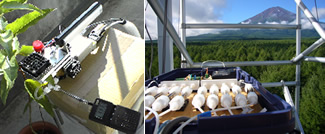Plant & Environmental Sciences

- account_circleAkira TaniPhD, Prof.
- account_circleNoboru MasuiPhD, Research Asst. Prof.
- Website:https://dfns.u-shizuoka-ken.ac.jp/labs/plantenv/
- Mail:atani@u-shizuoka-ken.ac.jp
- Phone:+81-54-264-5788
Studies on interactions between plants and the environment.
Plant production and ecosystem function
- 1. Air quality improvement by plants.
In order to investigate plant uptake capacity of chemical compounds in the atmosphere and soil, we use a special analytical device called proton transfer reaction mass spectrometry (PTR-MS). It enables us to monitor volatile organic compounds (VOCs) emitted and absorbed by higher plants.
- 2. Terpenoid emissions by plants.
Isoprene and monoterpene are major compounds emitted from higher plants. They rapidly react with reactive species such as hydroxyl (OH) radicals and ozone (O3) in the atmosphere and produce photochemical pollutants and aerosols. We investigate how the terpenoid emissions by plants are affected by the ongoing climate changes.
- 3. Plant cultivation under controlled environment.
Crop production in Asia is a critical issue to be considered. We try to develop a sustainable crop production system. Energy saving vegetable cultivation under controlled environment is our main concern, and we use solar panels specially developed for greenhouses.
- 4. Combining solar photovoltaic panels and food crop production
Solar photovoltaic panels above crop production fields provides benefits to farmers by selling electric power generated by the panels. Optimal density of the solar panels may differ for different crops and this has been unclear. In this study, we measure microclimate under the solar panel to address the optimal environment for crop production.
- Figure 1
- Gas chromatography mass spectrometry (left panel) and proton transfer reaction mass spectrometry (right panel).

- Figure 2
- Leaf cuvette method (left panel) and flux tower for field measurements.

References
- J Agric Meteorol doi.org/10.2480/agrmet.D-20-00025.
- Atmosphere 11, 793 (2020)
- J Agric Meteorol 76(1), 36-43 (2020)
- J Forest Res 25(5), 1-8 (2020)
- J Agric Meteorol 76, 1-10 (2020)
- Remote Sensing 12(9), 1505 (2020)
- Forests 11, 58 (2020)
- Sci Total Environ 745, 140886 (2020)